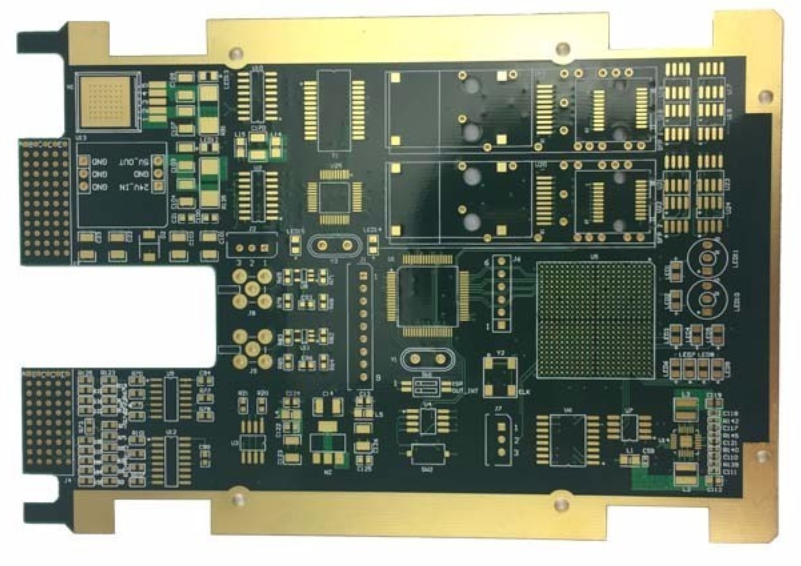+86 134 0021 8776
+86 134 0021 8776
Jul. 12, 2023
The laminated design of PCB is not a simple stacking of layers, in which the arrangement of the strata is the key, and it is closely related to the arrangement and direction of the signal. Compared with the design of the multi-layer board and the ordinary PCB, in addition to adding the necessary signal wiring layer, the most important thing is to arrange an independent power supply and formation (copper layer). In high-speed digital circuit systems, the advantages of using power supplies and strata to replace the previous power supplies and ground buses are mainly:
1) Provide a stable reference voltage for the transformation of digital signals.
2) Evenly add power to each logic device at the same time.
3)Effectively inhibit crosstalk between signals.

The reason is that the usage of a large area of copper as a power supply and formation greatly reduces the resistance of the power supply and ground, making the voltage on the power layer uniform and stable, and can ensure that each signal line has a very close ground plane response, which also reduces the characteristic impedance of the signal line, and can effectively reduce crosstalk. Therefore, for some high-end high-speed circuit designs, it has been clearly stipulated that a 6-layer (or more) stacking scheme must be used, such as Intel's requirements for PC133 memory module PCB. This is mainly to take into account the electrical characteristics of the multi-layer board, as well as the suppression of electromagnetic radiation, and even the ability to resist physical and mechanical damage are significantly better than the low-level PCB.
In general, the laminated design is carried out according to the following principles: to meet the characteristic impedance requirements of the signal; Satisfy the signal loop minimization principle; Meet the requirements of minimizing signal interference within the PCB; Satisfy the principle of symmetry. Specifically, the following aspects need to be paid attention to when designing multi-layer boards:
1)A signal layer should be adjacent to a copper coating layer, the signal layer and the copper coating layer should be placed at intervals, and it is best that each signal layer can be close to at least one copper coating layer. The signal layer should be tightly coupled with the adjacent copper coating layer (i.e. the thickness of the medium between the signal layer and the adjacent copper coating layer is very small).
2)Power copper and ground copper should be tightly coupled and located in the middle of the stack. Shortening the distance between the power supply and the formation is conducive to the stability of the power supply and the reduction of EMI. Try to avoid the signal layer sandwiched between the power layer and the ground. The close proximity of the power plane and the ground plane is like forming a flat plate capacitor, and the closer the two planes are, the greater the capacitance value. The main function of the capacitor is to provide a low impedance return path for high-frequency noise (such as switching noise, etc.), so that the power input of the receiving device has a smaller ripple, enhancing the performance of the receiving device itself.
3)In the case of high speed, excess layers can be added to isolate the signal layer, and multiple ground copper layers can effectively reduce the impedance of the PCB and reduce common mode EMI. However, it is recommended not to add more power layers to isolate, which may cause unnecessary noise interference.
4)The high-speed signals in the system should be in the inner layer and between two coppers, so that the two coppers can provide shielding for these high-speed signals and limit the radiation of these signals to the two copper-coated areas.
5)Priority is given to the transmission line model of high-speed signals and clock signals, and a complete reference plane is designed for these signals, avoiding cross-plane segmentation as far as possible to control the characteristic impedance and ensure the integrity of the signal return path.
6)When two signal layers are adjacent. For boards with high-speed signals, the ideal lamination is to design a complete reference plane for each high-speed signal layer, but in practice we always need to make a trade-off in the number of PCB layers and PCB cost. In this case, the phenomenon of having two signal layers adjacent to each other cannot be avoided. The current practice is to increase the distance between the two signal layers and make the lines of the two layers as vertical as possible to avoid signal crosstalk between layers.
7)It is best to set the copper layer in pairs, such as the 2, 5 or 3, 4 layers of the six-layer printed circuit board to lay copper together, which is to take into account the requirements of the balanced structure of the process, because the unbalanced copper layer may lead to the warping deformation of the PCB.
8)The sub-surface (i.e. the layer immediately adjacent to the surface) is designed as a layer to help reduce EMI.
9)According to the PCB device density and pin density, the number of required signal layers is estimated and the total number of layers is determined.
The structure of the PCB board layer is a very important factor to determine the EMC performance of the system. A good layer structure has a good effect on suppressing radiation in PCB. Most of the common high-speed circuit systems now use multi-layer pcb boards instead of single and double pcbs.
Hot Products
Navigation
+86 134 0021 8776
Floor 9, Aupu building, No. 395 XinShi North Road, Shijiazhuang Hebei, China
Request a Quote
